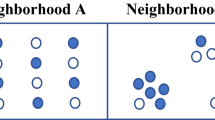Abstract
With the proliferation of social indicator databases, the need for powerful techniques to study patterns of change has grown. In this paper, the utility of spatial data analytical methods such as exploratory spatial data analysis (ESDA) is suggested as a means to leverage the information contained in social indicator databases. The principles underlying ESDA are illustrated using a study of clusters and outliers based on data for a child risk scale computed for countries in the state of Virginia. Evidence of spatial clusters of high child risks is obtained along the Southern region of Virginia. The utility of spatial methods for state agencies in monitoring social indicators at various localities is discussed. A six-step framework that integrates spatial analysis of key indicators within a monitoring framework is presented; we argue that such a framework could be useful in enhancing communication between State and local planners.
Similar content being viewed by others
References
Annie E. Casey Foundation (2003) Kids Count. Annie E Casey, Baltimore, MD
Annie E. Casey Foundation: 2005, Kids Count Data Book (Annie E Casey, Baltimore, MD)
Anselin L. (1988) Spatial Econometrics: Methods and Models. Kluwer Academic, Dodrecht
Anselin L (1994) Exploratory spatial data analysis and geographic information systems. In: M. Painho (eds) New Tools for Spatial Analysis (Eurostat, Luxembourg), pp. 45–54
Anselin L. (1995) Local indicators of spatial association-LISA, Geographical Analysis 27:93–115
Anselin L. (1999a) The future of spatial analysis in the social sciences. Geographical Information Sciences 5:67–76
Anselin L. (1999b) Interactive techniques and exploratory spatial data analysis. In: P. Longley, M. Goodchild, D. Maguire, D. Rhind (eds) Geographical Information Systems: Principles, Techniques, Management and Applications ( Wiley, New York), pp. 251–264
Anselin, L. and A. Bera: 1998, ‚Spatial dependence in linear regression models with an introduction to spatial econometrics’, in A. Ullah and D. Giles (eds.), Handbook of Applied Economic Statistics (Marcel Dekker, New York)
Anselin, L., Y.-W. Kim and I. Syabri: 2004, ‚Web-based analytical tools for the exploration of spatial data’, Journal of Geographical Systems 6, pp. 197–218
Anselin, L., I. Syabri and Y. Kho: 2006, ‘GeoDa: An Introduction to Spatial Data Analysis’, Geographical Analysis 38, pp. 5–22
Anselin, L., I. Syabri and O. Smirnov: 2002, ‚Visualizing multivariate spatial correlation with dynamically linked windows’, in L. Anselin and S. Rey (eds.), New Tools for Spatial Data Analysis: Proceedings of a Workshop (Center for Spatially Integrated Social Science, Santa Barbara)
Bramstedt, N. and W. O’Hare: 2002, ‘Examining Inter-Relationships Among State-level Measures of Child Well-Being’, (Annie E Casey, Baltimore, MD). www.aecf.org/kidscount/sda final 1.1 18.pdf
Buja A., Cook D., Swayne D. (1996) Interactive high dimensional data visualization. Journal of Computational and Graphical Statistics 5:78–99
Clayton D.G., Kaldor J. (1987) Empirical Bayes estimates of age-standardized relative risks for use in disease mapping. Biometrics 43: 671–691
Cliff A.D., Ord J.K. (1981) Spatial Processes, Models and Applications. Pion, London
Cressie N. (1993) Statistics for Spatial Data. Wiley, New York
Dorling, D.: 1996, Area Cartograms: Their Use and Creation. CATMOG 59 (Institute of British Geographers)
Goodchild M., Anselin L., Appelbaum R., Harthorn B. (2000) Towards spatially integrated social science. International Regional Science Review 23:139–159
Hawkins J., Catalano R. (1992) Communities That Care: Action for Drug Abuse Prevention. Jossey-Bass, San Francisco
Hugo G. (1994) GIS & socio-economics. GIS User 6:46–47
Kids Count: 1999, 1999 KIDS COUNT Online. (Annie E Casey, Baltimore, MD). http://www.aecf.org/kidscount/kc 1999/overview.htm
Kirby, R. and S. Foldy: 1998, ‚The role of geographic information systems in population health’, in R.Williams, M. Howie, C. Lee and W. Henriques (eds.), Geographic Information Systems in Public Health: Proceedings of the Third National Conference, (Centers for Disease Control, Atlanta, pp. 579–587
Land K., Lamb V., Mustillo S. (2001) Child and youth well-being in the United States, 1975–1998: Some findings from a new index. Social Indicators Research 56:241–318
Marshall R. (1991) Mapping disease and mortality rates using empirical Bayes estimators. Applied Statistics 40:283–294
Messner S., Anselin L. (2004) Spatial analyses of homicide with areal data. In: M. Goodchild, D. Janelle (eds) Spatially Integrated Social Science (Oxford University Press), New York, pp. 127–144
Page, P.: 1993. ‚GIS & social sciences’, in Proceedings of the Thirteenth Annual ESRI Conference, Vol. I (ESRI, Los Angeles), pp. 385–396
Plane D., Rogerson P. (1994) The Geographical Analysis of Population with Applications to Planning & Business. John Wiley & Sons, New York
Sampson, R.: 1993, ‚Linking time & place: Dynamic contextualism and the future of criminological inquiry’, Journal of Research in Crime & Delinquency 30, pp. 426–444
Society for Prevention Research (2003) Community Level Monitoring. http://www.preventionresearch.org/commlmon.php
Tukey J. (1977) Exploratory Data Analysis. Addison-Wesley, Reading
Upton G., Fingleton B. (1985) Spatial Data Analysis by Example. Wiley, New York
Voices for Virginia’s Children (2005) Virginia Kids Count Data Book. Voices for Virginia’s Children, Richmond, VA
Acknowledgments
Sridharan’s research was supported in part by a National Institute of Justice Grant 2002-IJ-CX-0010 to Westat. Anselin’s research was supported in part,by US National Science Foundation Grant BCS-9978058 to the Center for Spatially Integrated Social Science (CSISS).
Author information
Authors and Affiliations
Corresponding author
Additional information
Given cost considerations, the original color figures have been printed in black and white in this article. The color figures can be obtained from http://www.chs.med.ed.ac.uk/rubhc/evaluation/
Rights and permissions
About this article
Cite this article
Anselin, L., Sridharan, S. & Gholston, S. Using Exploratory Spatial Data Analysis to Leverage Social Indicator Databases: The Discovery of Interesting Patterns. Soc Indic Res 82, 287–309 (2007). https://doi.org/10.1007/s11205-006-9034-x
Accepted:
Published:
Issue Date:
DOI: https://doi.org/10.1007/s11205-006-9034-x




